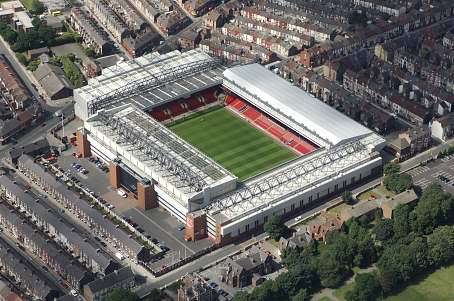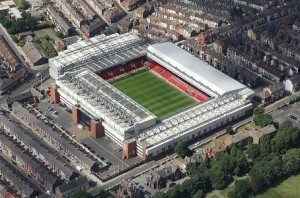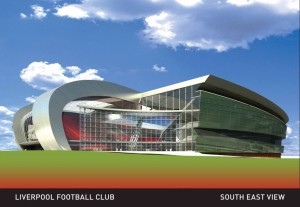
Redevelop Anfield or build a new stadium?
Let’s get one thing we can all agree on out of the way first – staying as we are at Anfield is not an option. Club accounts for the 2008-09 financial year showed Liverpool made £42m from gate and matchday income, while Arsenal were taking £100m at the Emirates turnstiles £109m came through the Old Trafford toilets. That means they have between £58 and £67 million more than us sloshing around their wallets.
Also, Anfield’s capacity currently lies behind United, City, Arsenal, Newcastle and Sunderland, with Villa and Chelsea quite close. Others may pass us soon – Spurs with a new stadium, even West Ham if they can come close to filling the new Olympic Stadium. Our average home gate is behind United, Arsenal, Newcastle, City, even Sunderland are close. Whichever way you look at, we’re stunted for growth.
Failure to compete financially means failure to compete on the pitch either. And sitting still means getting left behind by those in front of us, and maybe overtaken by those coming up behind.
So how do we increase match day revenues? The most obvious way would be just to charge lots more in admission prices – but that would also be the quickest way to empty the ground, especially in the current economic climate. Most fans would agree we’re paying more than enough already.
Another major potential income boost – perhaps the daddy of them all – lies in the exploitation of personalised on-demand TV worldwide, with the match beamed straight into your home, for a fee. In England, probably only United could rival Liverpool’s global reach and potential in this – something FSG will be well aware of. Hell, even Hicks and Gillett were. But that’s years down the line. With the income gap between us and the others widening all the time, we need to act sooner to reduce that gap. The big question is how – or more precisely, where – with a new, improved Anfield or by building a shiny new stadium?
Having been ruled out during the awful reign of Hicks and Gillett, the redevelopment of Anfield seems back on the agenda. We fans may be hopelessly romantic about it, but if John Henry and co. are seriously considering this option, as recently suggested, they must be confident that it would make financial sense. After all, nostalgia is one thing, making us top-level competitive quite another.
But could we get the 15,000 increase needed to bring the capacity of Anfield up to around the desired 60,000? Could redeveloping or expanding Anfield end up costing more than building a new stadium?
Assuming the Kop is sacrosanct, aside perhaps from a bit of in-filling in the corners to join the Centenary and the Main Stand, and the Centenary is already as high as it can go, it’s the Main Stand and the Anfield Road End that will most interest the developers. The latter has the complication of its eponymous road running right behind it – curse those Victorians who built their football grounds right in the heart of their communities, hemmed in by housing, factories, railway lines and roads. And you wonder whether it is possible to add sufficiently to the capacity of Anfield without prompting objections from the council, which may object to any developments that would tower over local properties or proposals to block or re-route Anfield Road.
It might be instructive to look at what FSG did with Fenway Park, home of the Red Sox in Boston. After all there are some close comparisons – like Anfield, Fenway Park is hemmed in by buildings, has plenty of heritage as arguably the oldest baseball shrine, and has a reputation for hosting passionate and vociferous fans. Preserving heritage seems to rank high on FSG’s agenda. At Fenway they made modernisation the priority rather than capacity, and added significantly to corporate hospitality capacity. The net result was a substantial increase in profit and income, but crucially, not as much as if they’d opted for maximising income and profit, the approach Hicks and Gillett would almost certainly have taken. If that had meant bringing in the wrecking ball and replacing the old shrine with a soulless concrete bowl without the fans’ backing, so be it. Mercifully that does not seem to be part of FSG’s philosophy.
Which brings us rather neatly to the issue of corporate hospitality. We may feel that prawn sandwich-eating fat cats may have little to do with following football, but there’s no doubt they’re a generous cash point for the clubs. Arsenal have a band of them circumnavigating the stadium, paying London prices for their Chateau Lafitte and hand-dived scallops in a white wine jus whilst glancing over for an occasional glimpse of Cesc and claiming to be Gooners born and bred. Meanwhile, Utd advertised for a head of catering at silly money to manage their team of Michelin-starred chefs (actually they’re not, but you get the idea. Actually the advert intro said ‘working for the world’s most glamorous football club’, which would have had a greater sense of honesty about it if it had said ‘working for the second most successful football club in the north west of England.’)
At the moment we have about 30 boxes along the Centenary Stand. We’re miles behind. Don’t get me wrong, I’m not advocating that corporate business should be first priority or anywhere near it, but it is an easy way to boost match day revenue quickly.
Of course, Anfield is so much more than its mere physical attributes. It has a personality too, quite a big, blousy, sentimental one, sometimes perhaps overly so, one that wears its heart on its sleeve, occasionally achieving an exuberant ecstasy like no other, always playing by its own rules. The emotional hold of Anfield is hard to overstate; the very name resonates way beyond the English game, across the whole football world community. ‘You’ll Never Walk Alone’, ‘This Is Anfield’, they’re part of football folklore. For the fans themselves, Anfield is church. It holds so many special memories, either experienced personally or passed down in song and tale across the generations. The pitch at the Kop end even hosts any amount of supporters’ ashes. Presumably none of them expected their final resting place to be the foundations for some city apartments or a new retail development. Project forward to the moment when the referee’s whistle blows at the end of the very last game at Anfield. The thought of that moment turns my inside to liquid mush. The wrench of leaving will be gut-twisting, no question. Staying at a new improved Anfield is unquestionably the emotional choice, though that’s by no means the only advocate for taking this option, there may be hard business and financial reasons too – and maybe also the absence of a viable alternative, of which more later. I take it as guaranteed that the Shankly Gates, the Shankly statue and of course the Hillsborough eternal flame will travel with us if we move.
Of course if we opt for the redevelopment route, we will need the co-operation of the local council and public authorities. Staying may give the immediate area a much needed boost – if you think the area by the ground is run down now, imagine it without its supporting life force. The businesses that rely on match day income – the pubs, shops and chippys – would also be mighty relieved. But that co-operation may not be forthcoming. They see a new build, rather than redevelopment, as the catalyst for the regeneration of north Liverpool. As recently as October 2010, the council leader Joe Anderson said that redeveloping Anfield instead of building a new stadium would be unlikely to gain approval. “I would encourage them to stick to the commitment that is already in place because I think that is the best solution for everyone – for the club and the city”, he said. I also seem to recall Hicks’ and Gillett’s proposals for extending the imaginary new stadium in Stanley Park beyond its initial 60/65,000 capacity meeting opposition over the inability of the public transport infrastructure to cope with crowds of 75,000. This may not be a smooth ride.
Whether we stay or move, you have to ask whether we’d fill all those thousands of extra seats. As our detractors and unhealthily obsessive LFC watchers (otherwise known as mancs) are so quick to point out, what do you need a bigger ground for when you can’t even fill the one you’ve got? Well there are plenty answers to why we’ve been below capacity occasionally, not least the uniquely excruciating pain of watching a Roy Hodgson team or the less-than-pulse-quickening prospect of Wigan at home on a cold winter’s night when there’s nothing much to play for. If we were title challengers you could forget about even trying to get a ticket, even for that game. No club will fill a stadium for every match if they’re playing mid-table dross with no prospect of winning or qualifying for anything – including the mancs. They’ve barely had a meaningless league fixture at Old Trafford for 20 years, testimony to their consistency at the top end.
But there’s a strange phenomenon that attaches itself to bigger new grounds, a sort of law of physics – attendances seem to expand to fill the space available. Look at Arsenal – OK they filled their 37-odd thousand Highbury, but did anyone seriously think they had another 23,000 tucked away, ready to wriggle out of their pupas as soon as they moved to the Emirates? Nothing before the move suggested so. Although it’s substantial, they don’t seem to have a fan base to compare with Liverpool’s or United’s. The same happened at Sunderland, and Derby. More go because more can. When people who had grown used to being excluded suddenly aren’t, it’s like removing a dam, a torrent follows. Presumably there are many who feel Anfield is impenetrable, they’ve no chance of getting tickets and have given up trying. So they’re not really ‘in the loop’ when one of that tiny handful of games that aren’t sold out comes around, they’re out of the habit and out of touch. But with extra capacity, they can get back into the habit. Assuming they’ve got the cash, of course. I have no qualms about us filling a 60,000+ capacity, assuming we’re a half-decent side with a chance of achieving something, I think we’ve got the unmet demand for it.
A Spade in the Ground?
A new stadium project formed part of negotiations right from when FSG first took over. In fact, that and the creation of a new Anfield Plaza on the site of the existing stadium, containing shops, offices and restaurants and providing a public link to the new arena, was a key condition in Liverpool getting permission to build on public land in Stanley Park. Crucially, building a new stadium and the Anfield Plaza are estimated to create 1,000 jobs in one of the most deprived local authority wards in Britain.
Meanwhile, Hicks and Gillett’s plans for a new arena on Stanley Park are still lodged, although I understand planning permission is due to expire in April. Of course, unlike their bombastic braying predecessors, FSG have made no rash promises about “spades being put in the ground within 60 days”, or even whether a spade will be put in the Stanley Park ground at all.
If it was, and a new stadium did indeed deliver on the 60,000 capacity, the extra 15,000 seats would produce, at £40 a seat, an extra £600,000 a match, or around £12/15 million a season, depending on cup games. There’d also presumably be a big uplift in corporate revenue, sponsorship and commercial deals. Even then, according to my maths we’ll still be some way behind Utd and Arsenal, but a lot closer. Offsetting that, it seems highly likely that, although the takeover itself left us debt-free, the new stadium (or indeed the redevelopment of Anfield) would not. The £350-400 million costs quoted for a new stadium would surely place the club in debt again, although this time with the additional earnings to service the debt. But isn’t the point of extra income being able to strengthen the squad and make us competitive with the super-rich and super-earners, not pay off debt?
Of course, there is one more issue associated with building a new ground, and it’s the elephant in the room. A curious blue one.
Sharing With the Other Lot
Ask a red. Or a blue, if you must. ‘No chance la’ might be the censored reply. As recently as last December, John Henry made it clear that if the fans don’t want a ground share, then the idea is a non-starter – and by the notoriously fickle vox pop method, most don’t. Even admitting you think it might be worth looking more closely at would be to bring about your social ostracism from fellow fans, not quite on a par with saying you are a Sun reader but getting there.
It’s not just that we can’t stand each other these days. Football in England’s nothing if not territorial, and Anfield and Goodison are our homes, integral parts of our identity for well over a century. Besides, who wants to see a compromise arena, with a red Kop at one end, a blue Gwladys Street ‘home end’ at the other, and all the other seats in between a vomit-inducing purple compromise hybrid? Maybe there’d even be two home changing rooms, one red and one blue, as well as an away changing room? (Also, corrugated iron panelling at the blue end so they feel at home? And isn’t it going to be half-empty every other week when they’re at home? – sorry, you see the problem.) Although it won’t mean sitting next to an Evertonian, you’d have to accept that one will be sitting in your seat next match.
Yet the idea is not without support. The Council has thrown its weight behind it, seeing the economic and tourism potential that an iconic new stadium could bring. And some icons of Merseyside football have come out in cautious support. In September 2010, in his then-capacity as Liverpool Ambassador, none other than Mr K Dalglish wrote “Whoever is in a position of responsibility at Liverpool and Everton are only custodians for the next generation of supporter. They owe it to the fans to look at every possibility to help their respective clubs.” Two months later, David Moyes said “I wouldn’t say we’d be definitely for it but we’d be very interested if we got an opportunity. I don’t know if that’s how Liverpool would view it.”
Last year, our chief executive, good ol’ Cec Purslow, met Everton counterpart Robert Elstone and other interested parties to discuss the options, but it went no further. What’s attractive about it, if indeed there is anything, lies in the reduced costs to both clubs compared to finding their own new homes – assuming that translates into an increased ability to compete on the playing field. Both clubs could also make profits on selling their current land, as Arsenal did with Highbury.
Of course the ideal solution would be for each club to have its own fantastic new stadium, but neither has had the financial infrastructure in place to do it so far. Whether FSG have remains to be seen.
The deal breaker is whether this route is better than the two clubs acting independently, whether it is the best way for both to ensure they challenge for honours year on year, and whether it is the route best equipped to deliver success for OUR club for the foreseeable future? If the others happen to get successful as well as a result, well it’ll only be like the ‘80s again and I’d settle for that. (As long as Thatcher doesn’t come back, that is. Oh, she sort of has, OK …)
The truth is, I don’t know. I don’t instinctively warm to the idea of ground sharing and I’m not an advocate of it, but I don’t dismiss it out of hand either. Don’t we owe it to ourselves to at least explore the possibilities?
“From Where I Was Standing: A Liverpool Supporter’s View of the Heysel Stadium Tragedy” by Chris Rowland is available in paperback and in Kindle format from Amazon.

